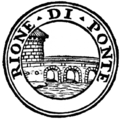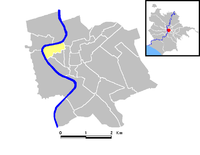
Ponte (rione of Rome)
Encyclopedia


Rioni of Rome
A rione is an Italian term used since the Middle Ages to name the districts of Rome, according to the administrative divisions of that time. The word originates from the Latin word regio A rione (pl. rioni) is an Italian term used since the Middle Ages to name the districts of Rome, according to...
of Rome
Rome
Rome is the capital of Italy and the country's largest and most populated city and comune, with over 2.7 million residents in . The city is located in the central-western portion of the Italian Peninsula, on the Tiber River within the Lazio region of Italy.Rome's history spans two and a half...
. Its name (meaning "bridge" in Italian
Italian language
Italian is a Romance language spoken mainly in Europe: Italy, Switzerland, San Marino, Vatican City, by minorities in Malta, Monaco, Croatia, Slovenia, France, Libya, Eritrea, and Somalia, and by immigrant communities in the Americas and Australia...
) comes from Ponte Sant'Angelo
Ponte Sant'Angelo
Ponte Sant'Angelo, once the Aelian Bridge or Pons Aelius, meaning the Bridge of Hadrian, is a Roman bridge in Rome, Italy, completed in 134 AD by Roman Emperor Hadrian, to span the Tiber, from the city center to his newly constructed mausoleum, now the towering Castel Sant'Angelo...
, which connects Ponte with the rione of Borgo
Borgo (rione of Rome)
Borgo , is the 14th historic district of Rome, Italy. It lies on the west bank of the Tiber, and has a trapezoidal shape. Its coat of arms shows a lion , lying in front of three mounts and a star...
. This bridge was built by Emperor Hadrian
Hadrian
Hadrian , was Roman Emperor from 117 to 138. He is best known for building Hadrian's Wall, which marked the northern limit of Roman Britain. In Rome, he re-built the Pantheon and constructed the Temple of Venus and Roma. In addition to being emperor, Hadrian was a humanist and was philhellene in...
(and originally named after him Pons Aelius) in 134 AD to connect his mausoleum
Castel Sant'Angelo
The Mausoleum of Hadrian, usually known as the Castel Sant'Angelo, is a towering cylindrical building in Parco Adriano, Rome, Italy. It was initially commissioned by the Roman Emperor Hadrian as a mausoleum for himself and his family...
to the rest of the city. Though Pope
Pope
The Pope is the Bishop of Rome, a position that makes him the leader of the worldwide Catholic Church . In the Catholic Church, the Pope is regarded as the successor of Saint Peter, the Apostle...
Sixtus V changed the rione limits so that the bridge belongs now to Borgo
Borgo (rione of Rome)
Borgo , is the 14th historic district of Rome, Italy. It lies on the west bank of the Tiber, and has a trapezoidal shape. Its coat of arms shows a lion , lying in front of three mounts and a star...
, not to Ponte any more, the area has kept its name. Its logo is obviously a bridge.
In ancient Rome
Roman Empire
The Roman Empire was the post-Republican period of the ancient Roman civilization, characterised by an autocratic form of government and large territorial holdings in Europe and around the Mediterranean....
, the area belonged to the IX Augustan region
14 regions of the Augustan Rome
In 7 BC, Augustus divided the city of Rome into 14 administrative regions . These replaced the four regiones or "quarters" traditionally attributed to Servius Tullius, sixth King of Rome. They were further divided into official neighborhoods ...
called Circus Flaminius, that was a part of the Campus Martius
Campus Martius
The Campus Martius , was a publicly owned area of ancient Rome about in extent. In the Middle Ages, it was the most populous area of Rome...
. Nero
Nero
Nero , was Roman Emperor from 54 to 68, and the last in the Julio-Claudian dynasty. Nero was adopted by his great-uncle Claudius to become his heir and successor, and succeeded to the throne in 54 following Claudius' death....
built another bridge, that was called Neronianus
Pons Neronianus
The Pons Neronianus or Bridge of Nero was an ancient bridge in Rome built during the reign of the emperors Caligula or Nero to connect the western part of the Campus Martius with the Campus Vaticanus , where the Imperial Family owned land along the Via Cornelia.- History :There is no direct...
or triumphalis because the Via Triumphalis, the Triumphal Way, passed over it: Starting with Titus
Titus
Titus , was Roman Emperor from 79 to 81. A member of the Flavian dynasty, Titus succeeded his father Vespasian upon his death, thus becoming the first Roman Emperor to come to the throne after his own father....
, the victorious Emperors celebrating their Triumph
Roman triumph
The Roman triumph was a civil ceremony and religious rite of ancient Rome, held to publicly celebrate and sanctify the military achievement of an army commander who had won great military successes, or originally and traditionally, one who had successfully completed a foreign war. In Republican...
s entered Rome marching through it.
Nero's bridge was also called Pons Vaticanus (meaning "Vatican Bridge" in Latin), because it connected the Ager Vaticanus to the left bank, later Pons ruptus ("broken bridge"), because it was already broken in the Middle Ages
Middle Ages
The Middle Ages is a periodization of European history from the 5th century to the 15th century. The Middle Ages follows the fall of the Western Roman Empire in 476 and precedes the Early Modern Era. It is the middle period of a three-period division of Western history: Classic, Medieval and Modern...
. In ancient Rome there was a port that was used to carry the materials for temples and great works to the Campus Martius.
The active life of the area went on during the Middle Ages and the modern period, and this activity deleted almost all signs of ancient Rome in the rione. The population increased because many people moved from the surrounding hills to Ponte because of the lack of water in other parts of Rome, since it was then possible to drink the water of the River Tiber
Tiber
The Tiber is the third-longest river in Italy, rising in the Apennine Mountains in Emilia-Romagna and flowing through Umbria and Lazio to the Tyrrhenian Sea. It drains a basin estimated at...
. Moreover, the rione was on the edge of Ponte Sant'Angelo, thus all the main streets of Rome were leading there and the area was full of pilgrims going to the Vatican. That is why it was full of locals, restaurants, shops of holy objects, etc.
During the 16th century the rione was very important for its streets; that is why several palaces of the greatest families of Rome were built according to the projects of famous artists, thus making the area very famous.
A common event in the area was to see a small procession led by a person dressed in black, covering his face, carrying a crucifix
Crucifix
A crucifix is an independent image of Jesus on the cross with a representation of Jesus' body, referred to in English as the corpus , as distinct from a cross with no body....
on his shoulders. On a wagon there was a chained condemned man kissing continuously another image of Jesus
Jesus
Jesus of Nazareth , commonly referred to as Jesus Christ or simply as Jesus or Christ, is the central figure of Christianity...
. The destination of the procession was the square in front of Ponte Sant'Angelo, where there were gallows
Gallows
A gallows is a frame, typically wooden, used for execution by hanging, or by means to torture before execution, as was used when being hanged, drawn and quartered...
to hang the man.
Although Ponte was a quite rich area, it was the most affected one by the frequent flooding of the River Tiber.
The look of the rione changed completely after Rome became capital of reunited Italy
Italy
Italy , officially the Italian Republic languages]] under the European Charter for Regional or Minority Languages. In each of these, Italy's official name is as follows:;;;;;;;;), is a unitary parliamentary republic in South-Central Europe. To the north it borders France, Switzerland, Austria and...
in 1870: the embankments of the river were built to stop the flooding and new bridges were made to connect Vatican City
Vatican City
Vatican City , or Vatican City State, in Italian officially Stato della Città del Vaticano , which translates literally as State of the City of the Vatican, is a landlocked sovereign city-state whose territory consists of a walled enclave within the city of Rome, Italy. It has an area of...
and the rione Prati
Prati (rione of Rome)
Prati is the XXII rione of Rome. Its logo is the shape of Hadrian's mausoleum, in a blue color on a silver background. Hadrian's mausoleum was not in this area, but in the rione Borgo, bordering Prati to the south. This is one of the wealthiest neighborhoods in Rome.In Piazza Della Libertà, on...
to the rest of Rome. All the narrow streets leading to the river were lost, to make space for the embankments, but it is still possible to see the typical look of the older rione in the inner parts of the area.
Churches
- San Giovanni dei FiorentiniSan Giovanni dei FiorentiniSan Giovanni dei Fiorentini, St John of the Florentines, is a church in the Ponte rione or district of Rome. Dedicated to St John the Baptist, the protector of Florence, the new church for the Florentine community in Rome was started in the 16th century and completed in early eighteenth and is the...
- Sant'ApollinareSant'Apollinare alle Terme Neroniane-AlessandrineSant'Apollinare alle Terme is a titular church in Rome, Italy, dedicated to Apollinare, the first bishop of Ravenna. It is the station church for Thursday fifth week in Lent.-History:...
- Santi Celso e Giuliano
- San Biagio degli Armeni (San Biagio della Pagnotta)
- San Salvatore in LauroSan Salvatore in LauroSan Salvatore in Lauro is a Catholic church in central Rome, Italy, located in the rione Ponte. It is the "national church" of the marchigiani, the inhabitants of the Marche region of Italy...
- Santa Maria del SuffragioSanta Maria del SuffragioSanta Maria del Suffragio is a 17th century church in central Rome on the via Giulia, in the rione Ponte.In 1592, the Confraternita del Suffragio was a purgatorial society established adjacent to the church of Saint Biagio della Pagnotta; their goal was to pray for the spirits of the dead and dying...
- Santa Maria dell'AnimaSanta Maria dell'AnimaSanta Maria dell'Anima is a Roman Catholic church in central Rome, Italy, just west of the Piazza Navona and near the Santa Maria della Pace church. It was the national church of the Holy Roman Empire in Rome...
- Santa Maria della PaceSanta Maria della PaceSanta Maria della Pace is a church in Rome, central Italy, not far from Piazza Navona.The current building was built on the foundations of the pre-existing church of Sant'Andrea de Aquarizariis in 1482, commissioned by Pope Sixtus IV. The church was rededicated to the Virgin Mary to remember a...
Deconsecrated churches
- Oratorio del GonfaloneOratorio del GonfaloneThe Oratorio del Gonfalone or Oratory of the Banner is a building in Central Rome which once housed a Catholic fraternity.Founded in 1264 under the name of the Accomandati di Madonna Santa Maria, over the centuries the group dedicated itself to various activities, including the participation in...
- San Simeone Profeta
- San Celsino (Oratorio di San Celso)
- Santi Simone e Giuda
Demolished churches
- San Salvatore in Primicerio

